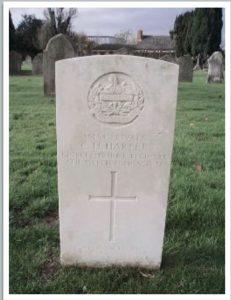13th Battalion, Gloucestershire Regiment

Clement Horace Harper was born in Cheltenham on 15 October 1881 and was the son of Thomas and Evangelina Taylor; his father was a tailor by trade. At the time of the 1891 Census the family was living at 2 Normal Terrace, Cheltenham.
On 18 January 1898 Clement joined the Great Western Railway Company aged 16 as an engine cleaner, initially based at Cheltenham and thereafter at Gloucester. On 29 January 1900 he was appointed a shunting fireman at Gloucester and he left this job on 6 October 1901.
According to the 1901 Census he was living in lodgings at Twyver Street in the All Saint’s parish of Gloucester. How he earned a living between leaving the railway and the start of the Great War is unknown, except for a hint on the 1911 Census return but he married, Ellen Webb, in Cheltenham in 1906.
The couple appears to have had two children, who were living with Ellen at a house at 5 Lime Kiln Row, Swindon Road, Cheltenham at the time of the 1911 Census. Clement’s name appears on the census return (showing occupation as bricklayer/labourer) but the entry is crossed through, indicating that he was absent on the census date. However, an entry for him elsewhere cannot be found.
Clement enlisted in the Gloucestershire Regiment in October 1914 and landed in France with the battalion on 21 September 1915. At some stage he transferred to the 13th (Service) Battalion of the Glosters, who were also known as the Forest of Dean Pioneers.
The Voters List for March 1918 notes his absence from Limekiln Row on active service. He appears to have survived the war but was discharged from the Army in March 1919. He died of unknown causes at Cheltenham on 7 March 1920, aged 38 and was buried in Cheltenham Cemetery, with a CWGC headstone marking the grave. He is also commemorated on the Cheltenham Town War Memorial.
It cannot be certain that Clement Harper is a war casualty in the true sense of the term because he appears to have survived the war and may have left the Army, in March 1919, under the demobilisation programme. No papers relating to any Army War Pension have survived and there is no record of a Silver War Badge, given to those who have left the service, due to injury or sickness.
However, if he died of sickness deemed to be related to his Army service then, up to the cut-off date of 31 August 1921, he would be included in the CWGC register as a war casualty. Perhaps this is the case. When the CWGC came to compile their register in the 1920s the relatives of the dead were contacted to provide details of next of kin. That provided for Clement Harper were details of his parents, then living at 12 St Paul’s Parade, St Paul’s Road, Cheltenham. Does this indicate an estrangement or separation from his wife Ellen?
Researched by Graham Adams 23 January 2013 with acknowledgement that some facts were taken from ‘Cheltenham in the Great War’ by Joe Devereux and Graham Sacker)
